|
A glimpse into the past...
Knotts and their
ten children were named Alma, Waldon, Blanche, Elsie, Eury, Samuel,
John, Velvie, Cora and Warren Stanliegh, all of whom spent the major
part of their lives in this area. Of these Cora is still living and
makes her home in Keota.
Of the above
mentioned children, Warren Stanliegh and Mary K. Gregory were married
June 30, 1926. The major part of this couple's lives were spent in the
Keota community and to them were born two children, James A. and
Marylen Jean (Mrs. Richard Smothers). Their earlier years were spent
farming and upon moving to town Stanliegh divided his time between the
Keota Creamery and carpentry, later initiating the existence of Keota
Kabinet Kompany. Stan, as everyone knew him, was taken from his family
and community very suddenly on April 14, 1962, and will probably be
remembered for his love of his grandchildren.
On May 5, 1951,
Richard L. Smothers and Miss Jean Henderson were married. Of their 11
children, Bill, Mary, Becky, Bonnie, Debbie, Lori, Jerry and Joni are
at home. Brad and Greg are serving with the Air Force and Jeffery will
enter the same branch this year following graduation.
July 23rd, 1950,
saw the marriage of James A. Henderson to Miss Virginia L. Clarridge of
Fairfield. Following a period of time in Houston, Texas, and one son
later, Douglas Nile, Jim and Ginny returned to Iowa and made their home
in Keota. Their family now includes Cynthia, Joyce, Judy, Sally and
John. Of these children all are at home except Cynthia, who is
presently studying cosmotology at Iowa City and Douglas who is
presently stationed in Germany serving with the U. S. Army.
It most certainly can be said that this is a typically
active family, proud to be a part of the Keota community. Their well
directed energies exemplifies the type of people for which this area
has come to be known.
By
James A. Henderson
Horras Family
On February 24,
1847, Wedelin Horras III, his wife Elizabeth and five children left
Germany to come to America. They left Germany with their friends the
Peiffers, Blaise and Berg families on board the ship Charlemagne.
They arrived in
New York, sailed around Florida to New Orleans and then up the
Mississippi River to Burlington, Iowa. The trip took 56 days. They came
to the Clear Creek area and Mr. Horras bought 20 acres of land for
$1.50 an acre. Mr. Horras was a carpenter by trade and was hired to
build log cabins for other settlers. His work was traded for livestock
or grain. Wages were 25 cents a day and you worked until you had earned
the value of one of these products.
Their first home was located one-half mile north of the
present Clear Creek Catholic Church. From there they moved one mile
east of Stony Point and later to Thornburg. The family finally settled
in the Blackhawk area. Two of Wedelin's daughters were killed in the
great tornado on May 23, 1873. One of the sons, Wendel, is the
forefather of the Horrases now in the Keota area. He married Elizabeth
Klein in 1866. They had seven children: Peter, Wendel, Casper,
Nicholas, William, Annie, Frank and John.
By
Mr. & Mrs. Gordon Horras
Hulse Family
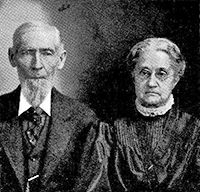
Minard and Eliza Hulse. |
Minard A. Hulse was born in Tompkins County, New
York, August 28, 1830. His father died when he was four years old and
the following year his mother took the family to Knox County, Ohio,
where he learned the carpenter trade. When 18 years old he and an older
brother, Addison A., went to Michigan where he lived until 1852. He
then moved to Sterling, Illinois, where he married Eliza Penrose on
June 30, 1853. He spent a number of years there farming and working at
the carpenter trade.
In 1865 the family moved to Keokuk County, Iowa,
and settled on a farm close to where Harper is now located. The nearest
trading point of any size was Washington, which was 25 miles away.
When Keota was started
Mr. Hulse sold his farm and moved t here in 1875. He
|
|
helped build many houses,
and also helped with the three-story brick, known as the Singmaster
building.
For some years he managed the furniture and
undertaking establishment of Henkle and Ritchey. In 1884 entered the
general merchandise business with his son-in-law, J.A.Y. Ashby. In 1887
A.A. Hulse purchased Mr. Ashby's interest and the firm became known as
"A. A. Hulse and Company" as it is called today.
Mr. Hulse was a member of the Town Board, also the
School Board. He was a charter member of Adelphia Lodge Number 353, AF.
and AM. He was an active member of the Methodist Church and Sunday
School, having served many years on the Board of Trustees.
He passed away November 27, 1913, and burial was
in Keota Cemetery.
A granddaughter, Mrs. Ruby Hulse Helscher, resides
in Keota.
|
 |
251
A glimpse into the past...
Kirkpatrick
Family
Theophilus
Kirkpatrick Comes to Iowa
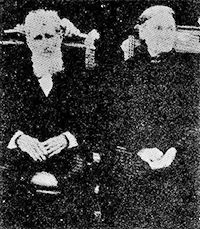
Theophilus and Sophia
Kirkpatrick |
October 4, 1866, Theophilus Kirkpatrick and his
son-inlaw, Samuel Leacox of Bureau County, Illinois, started the drive
to Iowa in a one-seated buckboard. Concealed in their clothes were two
thousand dollars in paper money, part of the receipts from selling some
land in Illinois. They crossed the Mississippi River by ferry at New
Boston, and arrived in Washington, Iowa, on October 9, 1866. There they
stayed with relatives. Washington was as far as the Rock Island
railroad was finished. The two men intended to drive on to Creston, but
the brown mare was lame, so they decided to stay another day or two. A
casual conversation with a local druggist brought out the fact that his
son-in-law was a land speculator. Mr. McGaughy suggested that he show
them a piece of prairie some 20 miles to the northwest of Washington.
So they drove out and called on Rev. Smock, who lived about a mile west
of the present town of Keota. He was also Keokuk County Superintendent
of Schools, and had a large wall map with section numbers. The
available land was located, and a search revealed mounds of dirt the
surveyors had dug to mark the corner of each quarter section. All
afternoon the men walked over |
|
the unfenced prairie.
Theophilus agreed to buy five quarter sections for $6,000 if Sam Leacox
would glve up the idea of going farther west for the so-called "free
land." It was agreed, and 800 acres changed hands for $7.50 per acre.
The following Monday the two men started back to Illinois.
In the spring of 1867 Sam Leacox and his
brother-in-law, Chalmer Kirkpatrick, built a house on the Iowa land,
and broke some of the prairie sod. In November, Theophilus made a brief
trip to Iowa for the purpose of buying a wood lot to provide fuel and
fencing material. After sowing wheat in the early spring of 1868,
Chalmer returned to Illinois too.
On April 27, 1868, Chalmer and his mother, Sophia,
and sister, Sarah, set out for Iowa, driving a team hitched to a
covered wagon, while two younger brothers, Scott and George, drove a
herd of cows. Theophilus spent the next few days in Illinois packing
goods for shipment by train. On May 21 he recorded in his diary that he
paid freight of $34.50 on 4,660 pounds of household goods and an organ.
The same day he started for lowa driving a single horse hitched to the
buggy, and leading a colt. He joined relatives in Washington on May 29.
An entry in his diary is dated at the farm north of the present town of
Keota, "Sabbath, May 31, all at home in Iowa."
In 1872 the Rock Island railroad was built across
Keokuk County, and the town of Keota was started two miles south of the
Kirkpatrick homestead .
In 1874, the year the NW quarter of Section 13,
Lafayette Township, was purchased by Theophilus, the price was $18.10.
This quarter section was deeded to Renwick Scott on March 1, 1878, his
21st birthday. This land included the present home of Scott's
grand-daughter, Mrs. Omar J. Stoutner and family.
|
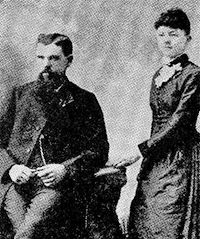
Scott and Maggie Kirkpatrick |
On December 9, 1882,
Sarah sold her southwest quarter of Section 12 to her brother Scott for
$33.25 per acre. Unfavorable weather plagued Scott for the next three
years, but he managed to keep the farm program going. He married Maggie
Klein on February 17, 1886.
Scott and his father-in-law, John Klein, put in
many rods of tile which still continue to work well. More tile had been
added to drain the largely flat acres. Scott built a barn in 1890
(still standing), a double corn crib, and in 1902 a modern home (where
the C. D. Kirkpatricks live) at a cost of $3,500. Also the farm
provided money for a trip to Germany with "Father Klein" in 1900, and
paid the college expenses for Charles at Coe, 1907-1911.
The name "Walden Farm" was registered in 1911, the
first in the county after the law was passed allowing exclusive
registration of farm names.
|
McCampbell
Family
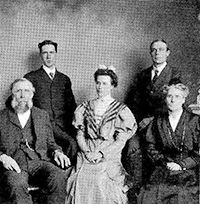
Andrew McCampbell Family |
Robert S. McCampbell was born April 5, 1810, in
New California, Ohio, to William McCampbell, Sr. and Jane Cooper. He
was married March 1, 1836, to Elizabeth Porter. Robert and Elizabeth
moved to Iowa in 1854 by covered wagon bringing five children with them
and settled on a farm in Keokuk County, Iowa, near Talleyrand.
One of their sons, Andrew McCampbell, born January
15, 1843, was a veteran of the Civil War. He married Agnes A. Taylor on
January 20, 1875. They were the parents of three children—John L.
Campbell, born January 12, 1876, married Anna Frederick in 1910. She
died November 1913. He married Clara Wiltsee Hannon in 1939. They are
buried in Mohall, North Dakota, which was their home.
|
252
|
Amanda M. McCampbell,
born March 1, 1881, was married to Andrew H. Brinning, Novem
ber 1, 1905. They are
buried in the Keota Cemetery. They were the parents of one son, Gayle
Leonard Brinning. Gayle Brinning, born July 28, 1916, married December
11, 1943, to Alice S. Wulf. They were the parents of three boys: John
Charles, born April 28, 1946, married Mary Rau of Big Springs, Texas,
March 1967. Parents of one daughter, Mary Michelle Brinning, born
January 22, 1969. Another son, Roger Gayle Brinning, born October 24,
1949, married April 1971. Parents of two children: Michael Shane, born
November 9, 1971, and Sonja Jean, born November 7, 1972.
Thomas Andrew Brinning was born June 2, 1952.
|
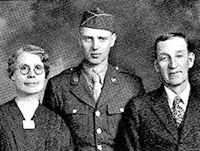
Amanda, Gayle and Andrew Brinning |
|
Another son of Robert S.
and Jane Cooper McCampbell was Charles Andrew McCampbell. Born October
10, 1883, married to Ellen Marr, October 1, 1938. She died October 20,
1944, and Charles in July 1968. Both are buried in the Keota, Iowa
cemetery. Charles McCampbell was a director of the Keota Farmers
Savings Bank for many years and in his memory there is a time and
temperature recorder in front of the new bank building.
The Gayle Brinning family is the fourth and fifth
generation to be living on the old McCampbell homestead near Talleyrand.
|
McCrabb
Family
Life
of Joseph Ankrim and Martha Maria (Smith) McCrabb
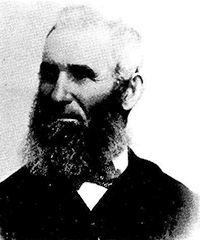
Joseph McCrab |
Joseph A. McCrabb, son of James Henry and Eliza
Jane (Hutton) McCrabb, was born in Lancaster County, Pennsylvania, July
19, 1836. He grew to manhood there and became a miller by trade. He had
a great desire to go West. and explore the new country as many ot hers
were doing. So, when in his early twenties, he headed for the western
frontiers with other early pioneers, in a covered wagon train over the
famous Appalachian Trail. Most of the way he rode horseback as a guard
against Indians and outlaws.
By 1859 he had settled
in Ogle County, Illinois, and had a job as a miller. It was there he
met Martha Smith, who had been living there with her parents and family
on their homestead four miles northwest of Polo, since 1851. He and
Martha were married September 11, 1861, on her birthday, at Freeport,
Illinois, and they continued to live in Ogle County for another three
years. By then several of the
|
|
families wanted to move
on farther West. So early in the summer of 1864 they had several
covered wagons ready to go, and the Isaac Smith family, the James Smith
family, the Jonathan Smith family, the Joseph McCrabb family and the
James Lyle family all headed west together for Iowa. Jonathan Smith,
their father, also came along on that trip but he was already an old
man and the wagons rode so rough that they made him sick, so he rode
most of the long trip in the buggy. There were only a few roads and no
bridges in those days. They crossed the Mississippi River at Clinton,
Iowa, and most of the way they came straight west across the prairie.
All these families settled on the good farming land in eastern Keokuk
County.
After two years the
Isaac Smith family moved on farther west to Dallas County and settled
on the good land about fifteen miles southwest of where Perry now
stands. The Jonathan and Rebecca Smith family stayed in this community
with the others for seven or eight years, and then returned to Ogle
County, Illinois. But, they were not satisfied there and after a few
years they migrated in covered wagons across
|
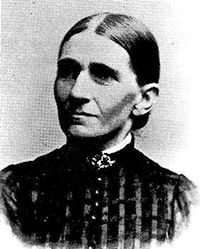
Martha Marie McCrab |
|
Iowa and settled in
southeastern Nebraska, in Pawnee County, in the year 1878. Jonathan
Smith, the father of all these families, who took turns staying with
his children after his wife's death January 3, 1857, passed away at his
youngest daughter's, Mrs. Joseph McCrabb's home, December 8, 1871, past
81 years of age. He is buried on their lot in the Lafayette Center
Cemetery.
Times were rough in those early days when the
folks f irst came to Iowa. Many Indians were camped and living along
the rivers, and they would wander out over the prairie, hunting and
trying to find something to eat. Many of them came to grandfather's
home, begging for chickens and other things to eat, and would nearly
scare the women folks and children to death, because they had heard
such terrible stories about them. But nearly all these were friendly
Indians and gave them no trouble.
In those early days Grandpa farmed with both oxen
and horses. I saw several ox yokes in his barn. The men had to sow all
their small grain by hand for years and cut it with a heavy scythe that
had a cradle on it to catch the grain and hold it even, so it would be
easy to tie in bundles. When they got the grain ready for market they
had to haul it across the prairie 22 miles to Washington, for Keota was
not there then. Grandpa would take a wagon and four horses and
|
253
A glimpse into the past...
strike out
across the prairie, for there were no roads then, and drive to
Washington with a load of grain one day and stay all night. The next
day he would drive back with a load of groceries and whatever they
needed. Many times he wouldn't get home until after dark and grandma
would put a lamp in the window so he could see it and tell where their
house was. This would especially help during a bad rain or snowstorm.
Sometimes they would get lost and have a terrible time to find the
house.
My mother, Zelia
McCrabb Cummings, the youngest daughter of Joseph and Martha McCrabb,
was born in this house January 11, 1872. That makes her one year older
than the town of Keota. In fact she grew up with Keota. In 1885 Joseph
and Martha McCrabb built themselves a new home. It was a large
two-story frame house with a porch clear across the front. That house
still stands today, three miles north of Keota on the Kinross Road.
In the fall of
1900, my father, Fred Cummings, came driving through the country with a
horse and buggy from Pike County, Illinois. He helped different farmers
get their corn picked and turned out to be a champion picker. At that
time they paid 2 cents a bushel for picking corn with room and board.
Joe McCrabb hired him to help him get his corn out. He did and then
hired out to Dan Dill to break horses for him that winter. While he was
picking corn for Joe McCrabb, he took a liking to his youngest
daughter. They started going together and were married March 5, 1902,
by Rev. H. A. Pallister in Keota. That same year they rented land up
near Parnell and started farming. His good friend, Joe Romine, loaned
them enough money to help them get started farming. The next year I
came on the scene and was born January 21, 1903, at my grandparents'
home three miles north of Keota.
There was a grist
mill on English River, over north of Wellman, which was 13 miles from
grandpa's home. For many, many years he would load up the wagon with
sacks of wheat and corn and drive to the mill and bring back flour,
cornmeal, chicken feed, etc. I remember once of going with him on this
thrilling trip when I was just a boy.
About the time of
the First World War, some car dealers tried to sell Grandpa a new Model
T Ford. They took them rides in it and tried several times to sell it
to them. Finally Joe said, "I will buy the car if Eliza will drive it."
Eliza was his oldest living daughter who stayed with him and kept house
for him after his wife unexpectedly passed away March 7, 1905. Eliza
said, "I don't think I can drive it, and anyway I am afraid of them
things." So he didn't buy it, and they never did buy a car.
Joseph McCrabb bought his 160-acre farm from the United
States Government for 50 cents an acre, and lived there all the rest of
his life until one year before his death, when they moved to Keota. In
later years he bought another 80 acres of land to add to his farm.
During the land boom after the First World War in 1918, he was offered
$500.00 an acre for his farm but refused to take it. In 1921 he bought
a home in Keota and they moved to town. Joseph A. McCrabb passed away
at his home in Keota June 13, 1922, at the age of 85 years, 10 months
and 25 days. He is buried with his wife and daughter, Eliza, on their
lot in the old part of the Keota Cemetery.
Harold
Cummings
Des Moines, Iowa.
Dr.
McFarlane Family
One of the first
doctors practicing medicine in Keota was Dr. Daniel McFarlane. He was
born and raised in Loch Gailhead, Argyleshire, Scotland. He received
his medical education at Edinburgh University in Scotland. He left
Scotland in 1864 and practiced medicine five years in Canada. He
settled in Keota in 1872. He also owned a Drug Store here, and
practiced his medicine until his death in 1901. Dr. McFarland and his
wife, Mary (Disor), a Keokuk County native, had two daughters. Sarah
married C.A. Singmaster and Margaret married Elmer Erdice, a Keota
jeweler. Three grandchildren still living in the Keota vicinity are Sam
of Sigourney, Iowa; Robert, Keota, Iowa; Mrs. Clyde Stoutner Jr.,
Keota, Iowa. A great granddaughter, Mrs. Harold Fink (Sally Mayer), now
of Tennessee, is a former Keota resident.
McLoud
Family
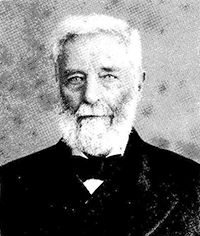
William McLoud |
William Mcloud was born at Hartland, Hartford
County in Connecticut, November 14, 1818.
He was married to Catharine Barbour of Hartford.
He spent his younger days in various occupations, working on farms and
doing carpenter work during the summer, and teaching school in the
winter.
In 1854 the family started for Iowa. While passing
through Ohio, the oldest daughter, Mary, became ill, passed away and
was buried there. They spent their first winter in Keokuk County,
living in a double log cabin with the Joe Kramer family near Clear
Creek.
They then moved to a
farm 1/2 mile east of the present location of Harper. A school
|
|
house was erected on the
farm and Mr. McLoud became the first teacher in Lafayette Township.
While living there a son Winthrop passed away and was buried in the
yard. When Lafayette Center Cemetery was opened the body was removed
and was the first burial there.
When Mr. McLoud was no
longer able to farm they moved into Keota in 1884 and lived in the
street now known as North Davis. A son-in-law, Mr. B.T. Coffman and
family of near South English, moved to the farm. In 1892 a house was
built on the farm, near the first house, where Mr. and Mrs. McLoud
spent the rest of their lives. Mrs. Mcloud passed away in 1895 and Mr.
McLoud in 1897.
Mr. McLoud held most of
the township offices and later served as a Judge, Auditor and a member
of the Board of
|
254
A glimpse into the past...
Supervisors of
Keokuk County. Judge McLoud liked books and spent many hours reading.
Every Saturday evening the family was seated while he read aloud the
poem "The Cotter's Saturday Night" by Robert Burns.
It was said of
him that he was a man of strict honor and integrity—always ready and
willing to lend a hand where help was needed. Mr. and Mrs. McLoud were
members of the Methodist Church in which they took an active part.
Mr. McLoud joined
the Masonic Lodge in Talleyrand and later transferred to the Keota
Lodge.
Mr. Mcloud's
funeral was held in the Keota Opera House, January 28, 1897, conducted
by Rev. Chew of the Methodist Church, assisted by Rev. H. H. Brownell.
Burial was in the
Keota Cemetery under the Auspices of the Masonic Fraternity. All of the
family was able to attend Mr. McLoud's funeral. They included Dr.
Edward McLoud, a veteran of the Civil War, at that time a Doctor in
Cincinnati, Ohio; Catherine, Mrs. B.T. Coffman who lived on the home
place; Jennis, Mrs. C.H. Robinson of Massena, Iowa; Ellen, Mrs. Percy
Farley of Washington State; W.S. McLoud of Valley Junction, Iowa, a
railroad conductor; also, James Daniels, who was brought from
Connecticut as a "Bond Boy."
At the present
time there are five grandchildren living: Mrs. Ellen Boggs, New
Brighton, Minnesota; Winthrop Robinson, Buffalo Lake, Minnesota; Clyde
Farley, Kent, Washington; Mrs. Irene Cupp and Mrs. Theresa
Schreckengast, both of Keota, Iowa.
Peiffer
Family

Paul and Magdalena Peiffer |
Paul Peiffer was born at Besch, Regierrungsbezick
Trier, Germany, October 1, 1812, and was a stone mason by trade.
Magdalena Redlingier was born at Oberperl, Germany, December 24, 1813.
They were married at Oberperl, January 21, 1837. He wit h his family,
wife, three boys, one girl, namely Nicholas, John, Michael and Mary,
left Antwerp, March 22, 1847. They were bound for New Orleans. Their
reason for leaving Germany was that times were getting hard, land was
high priced, too thickly populated in Rhine Province. There also was a
much-hated law that every young man had to go into military training
from the age of 18 to 21 years.
It is said that 72
days elapsed from the time they left the old home until they arrived in
Clear Creek Township, Keokuk County, Iowa. They came to Burlington,
Iowa. Three other families migrated with them. As following Mathias
Trits who went on to Dubuque, Iowa, Wendel Horras and Michael Berg
along with the Peiffers found
|
|
their way to Clear Creek
Township by the way of a wagon trail. The three men left their families
in Burlington, Iowa, and started out on foot to find the Besser family.
Also the three Kramer brothers who had migrated to Clear Creek Township
in 1845. After finding the Bessers and Kramers these three men bought
their land and hired a team and wagon to haul their families out to
Clear Creek.
Mr. Berg had bought 40 acres for $1.50 per acre
with a log house on it. Mr. Peiffer and Mr. Horras each bought 20 acres
at $1.50 per acre. Mr. Peiffer's 20 had a log house but the Horras' did
not. Mr. Peiffer had the Horras family live with them until they could
get a new log house built. The Peiffers' log house was 14 x 16 foot.
They lived together for three months. The original Peiffer home was 1
1/2 miles northwest of the present Clear Creek Church. Anthony Weber
lives on the original farm.
Mr. Horras was a carpenter and built many log
houses. At one time he built one house in six days and received $3.00
for his labor. This was the first time cash money was paid for labor.
Mr. Peiffer's farm had five acres of corn on it when he bought it. Mr.
Berg, Mr. Horras and Mr. Peiffer each bought a pair of oxen at $25 per
team. They bought one breaking plow together and hitched their three
pair of oxen on this one plow. Their wagons were homemade. For wheels
they would take a large log and saw off pieces three to four inches
thick. A large hold was bored through the center and a wood pole was
used for the axle. These wagons were their conveyances for six years or
longer.
One winter there was a severe snow storm. The snow
was about three feet on the level. This snow stayed for about six
weeks. People could not get out to see their neighbors. Most of the
peoples' corn meal supply was exhausted in a short time. They would
take a big kettle, fill it with ear corn and boil it. After it was
boiled they would grate it. This they would use to make corn bread.
After the snow melted, the people went to the mill on the Skunk river
and had corn ground.
In 1854 Father Krackel, the first priest that ever
visited the settlers, came from Burlington. In 1857, Father Krackel
proposed that they build a Church. Baden was the place of the first
Church in 1857. The first Church at Clear Creek was completed in 1863.
On May 22, 1873, a tornado went through this section. Three people were
killed-Mrs. Marsch and her child and Mrs. Engeldinger.
Corn was their only crop the f irst years. After
that they started to raise wheat and potatoes. Talleyrand was the
market center in early times. The first years of their settlement they
raised a few hogs. In late fall they would butcher the hogs and salt
cure the meat. Later they would go to Burlington and take along the
salt cured meat and sell it for 2 1/2 cents a pound or trade it for
staple groceries, such as salt peter, flour, sugar, etc. This was for a
year's supply. Later the livestock - sheep, hogs and cattle, were
driven to Talleyrand and then in larger herds to Washington. Hogs were
2 1/2 to 3 cents per pound. The prairies were all prairie grass which
made good hay. The people could cut as much as they needed for winter
use and haul it home and stack it up in piles.
|
255
A glimpse into the past...
During the 1850's
is when this territory populated the fastst. Most of the people came
from Germany. In spite of the hard times in those days, the people were
sociable and happy. Everyone was ready to help each other if in need.
In 1853 a man by the name of Jinks started a store at the place which
is called Talleyrand. This was about half way between Washington and
Sigourney which were small towns. Eggs were two cents a dozen.
Talleyrand at one time had two dry good stores, hardware store,
grocery, clothing store, two blacksmith shops, drug store, studio,
saloons, hotel and post office. There also were two resident doctors
and a cheese factory. Talleyrand was on the stagecoach line between
Washington and Sigourney.
Sheep was the
first livestock raised by the settlers. They would use the wool to make
their clothes which were homemade.
In 1872 they saw
the railroad come through.
The family of Paul Peiffer and wife, Magdalena, were born
in Germany as were Nicholas, John, Michael and Mary. Those born at
Clear Creek, Iowa, were Joseph, Peter and Wendel. There are many
Peiffers scattered over the U.S.A.
By
Msgr. N. J. Peiffer, Earnest Peiffer and Elmer N. Peiffer
Pool
Family
Ezra Pool born in
1842 and his wife, Alice Clark, born in 1846.There were three living
children born of this marriage; Herbert J. born in 1878, Sarah L.
(Sadie) born in 1882, Clarence L. born in 1885. Two grandchildren were
born; Marjorie Pool Luscombe (living) and Chrystal Pool Curtis
(deceased); and four great grandchildren. Ezra Pool died in 1917. Alice
Pool, his wife, died in 1922 at Keota, Iowa.
They raised their
three children on their farm north of Keota. The two boys moved away
and established homes. Sarah (Sadie) married Loren Longwell and they
became owners of the farm, living there all their lives.
About 1908, Ezra and Alice Pool retired from farming and
moved to the corner of Washington and Davis streets, across from the
Christian Church. They were life-time members of the Christian Church.
The children, Herbert, Sadie and Clarence, are deceased and the farm
was sold November 1972.
Submitted
by Marjorie Pool Luscombe
Isaac
Leroy Pulver Family
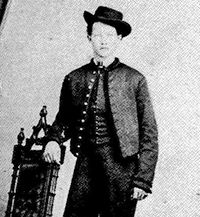
Isaac LeRoy Pulver |
Isaac LeRoy Pulver (May 5, 1846-June 13,
1928) soldier, patriot, farmer, carpenter, and musician, was born in
Richland County, Ohio, the third son of Isaac and Hannah (Armstrong)
Pulver. His father was a carpenter and he learned the trade working for
his father. At 15 years of age he became a member of the drum corps of
his home town of Mansfield, Ohio, and helped recruit volunteers for the
Civil War. A year later, with parental permission, he enlisted in Co. C
163rd Ohio Volunteers. They were first ordered to Columbus, Ohio, where
they played around the court house, doing recruit duty. Next they were
ordered to Washington, D. C., where they marched up Pennsylvania Avenue
and played in front of the capitol. President Lincoln came out and
addressed them from the steps. His words were one of the most cherished
memories of his life. He continued to play with the drum corps of old
Co. C. until the close of the war—a year and a half.
|
|
In 1867 he was united in marriage to Sarah
Catherine Lutz (August 23, 1848-September 20, 1915) in Little
Washington, Ohio, and here they lived when their first two children,
Elza and Elmer Pulver, were born. The call of the west lured him as far
west as Kansas in 1870, but he finally decided to settle in Dublin,
Iowa, where his half brother, Madison Pulver, and family were living.
Here Edna (Pulver) Davis was born. Their next move was to the "Old
Belchee" farm on Dutch Creek, which became the family homestead. Here
Clark, Elma (Pulver) Romoser, Harry, and Clara (Pulver) Teets were born.
Life on the farm was enlivened by the sounds
of music of the Pulver family. The surrounding hills would echo to the
sounds of the drums. Mrs. Pulver played the bass drum. The sons were
taught to play with their father and also the neighborhood boys were
gathered in. The Sturgeon boys joined this group. The martial music
stirred their blood to greater patriotism and loyalty to the old flag.
Eventually a drum corps was organized which was known as the Pulver
Drum Corps, and this group furnished patriotic music for all Memorial
and Decoration Days, and for many Fourth of July celebrations.
With the passing of the older children from
the homestead, the Pulvers decided to move to Keota, and in 1903 they
purchased a modest home beside which a carpenter shop was erected. The
Pulvers affiliated with the Methodist Church. He became an enthusiastic
member of the G.A.R. and acted as Commander of the Post for a time. He
also attended three of the National Encampments, one of which was in
Columbus, Ohio. There the members of the drum corps rode on the flat
bed of a truck, through the parade route, playing the same martial airs
they had played in that city 56 years previous. A sign on their truck
confirmed this, and the enthusiasm of the crowds looking on was high.
When the Washington, Iowa, Legion Drum Corps
was being organized, several members came to Keota to have Mr. Pulver
play for them, so that they could observe his techniques, for he was
known as one of the best drummers in the state.
During the lifetime of this couple, several
members of their relatives in Ohio migrated to this area to live,
including George Jacot Lutz, his son and wife, "Benny" Pulver, a
brother of Le Roy with his two sons Fred and Frank Pulver, and James
and Harvey Banks, nephews of Mr. Pulver.
The Pulvers maintained close and
affectionate ties with their relatives.
|
|
256
A glimpse into the past...
Mrs. Pulver
suffered a gradual sight loss during her last years. To compensate for
this, her thoughtful husband would read every issue of The Eagle to her
in its entirety, while she listened intently. When speaking of his
wife, Mr. Pulver always maintained that she knew just how to get along,
to do without, and how to save in order to help out. "Everything she
did was right," he would say with a characteristic gesture of his hand.
What greater accolade could there be?
Mrs.
Irene (Davis) Eaton, granddaughter
William
Madison Pulver Family
William Madison
Pulver came to Iowa from Ohio at the age of 25 in the year 1854. In
1858 Jane Alexander came out from Ohio by prearrangement, and the
couple was married in October of that year. They moved into a log house
south of Dublin. Here the first three children were born — James,
Samuel, and Amanda (Mrs. Fred Mangold). Later they moved to a f arm two
miles north of Dublin. Here the other three children were born — twins,
Isaac and Hannah (Mrs. Alex Moody), and Jennie (Mrs. Will Erwin). In
the f all of 1899, Mr. and Mrs. Pulver moved to Keota and lived on the
south side in a home which they occupied until their death. Both lived
to be 84 years of age.
Madison was a
carpenter, having learned the trade by working with his father in Ohio.
Sometimes he worked with his half brother, LeRoy, and sometimes by
himself. When working on a carpentering project, these men would live
on the premises of the people who hired them, receiving food and
lodging there. They would walk home on Saturday night and be with their
families for Sunday. They were luck y if they had a ride — sometimes
they would have to walk as much as 14 miles to get home. There were
many buildings in the Dutch Creek Township area that were built by the
two men.
After moving into Keota, Mr. and Mrs. Pulver celebrated
their 50th wedding anniversary. Their six children and 14
grandchildren, plus other relatives, were present for the celebration.
Mr. Pulver continued to do some carpentry work after moving into Keota.
By
Louise (Pulver) Schwamb
John Linn Ramsey Family
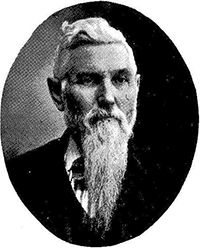
John Linn Ramsey. |
John Linn Ramsey was born in Hillsboro County, New
Hampshire, September 17, 1830. His father, Eben Ramsey, a native of
that state, was a farmer. His father, Samuel Ramsey, came from Scotland
and fought in the Revolutionary War. He married Elizabeth Wilson and
settled on a farm in Greenfield, Hillsboro County, New Hampshire. The
father of J. L. Ramsey married Mary D. Butler, a relative of Franklin
Pierce, Horace Greeley and General Benjamin Butler. Mrs. Ramsey was
born in Bennington, New Hampshire, was a daughter of Moody Butler of
Scotch-Irish descent. The father died in 1836. The mother afterward
married Amzi Jones. The mother died at age 85.
J. L. Ramsey was the
second son born of the first marriage. At the age of 16 in 1846, he
moved to Yates, New York, near Buffalo, where he attended school and
afterward taught school. In 1849 he taught in Lexington, Kentucky, for
one year. He then went to Cincinnati, Ohio, and worked as a fireman on
a railroad for six months. He was
|
|
promoted to engineer
until 1854 and then moved to Chicago where he served as an engineer on
the Rock Island Railroad. During his last years with the company he was
station agent in Bureau, Illinois. In 1880 he located in Keota, Iowa,
where he engaged in the grain business, building the first elevator
there. He sold out and retired in 1893.
On January 28, 1857, he married Mary E. Nelson,
who was born in Lexington, Kentucky, December 14, 1833, and became the
mother of six children: Elizabeth, Virginia, John N., Georgia T. (wife
of A. A. Hulse-a Keota merchant), Eben J. (a Keota furniture dealer),
and Emma C.
Mr. Ramsey was a staunch Republican from the
organization of the party. He was personally acquainted with such
celebrities as John A. Logan, General Sherman, Richard Yates Sr. He was
Mayor of Keota for 12 years and member of the School Board for 15
years. He was a prominent Mason, belonging to Adelphi Lodge No. 353 at
Keota. He attained the 32nd degree in the Scottish Rite. He also held
all of the offices in the Blue Lodge, the Council and Commandery. He
was also Grand Engineer of the Brotherhood of Locomotive Engineers and
a member of the Independent Order of Odd Fellows. He died December 12,
1913.
|
Sanders
Family
The Sanders
family is of English descent. Samuel Sanders was born June 8, 1766, in
Maryland. He was married to Nancy Reid on June 2, 1785, in Rockbridge
County, Virginia. Samuel served as a private soldier in the War of 1812
from Bourbon County, Kentucky. He served first as a substitute for
Thomas Arrowsmith, drafted in Bourbon County, and again served as a
substitute for John Stewart of Bourbon County.
Samuel and Nancy
had 11 children, five sons and six daughters. Henry Sanders, the first
son of Samuel Sanders, was born August 28, 1788, in Botetourt County,
Virginia and was married on January 23, 1816, in Bath County, Kentucky,
to Martha Johnston Ralston. Patsy, as she was called, was born November
20, 1799, in Bourbon County, Kentucky. She was the daughter of John
Ralston and Elizabeth Neely Ralston and Elizabeth Neely Ralston and the
granddaughter of Joseph Neely and Martha Johnston Neely, all of
Scotch-Irish descent. Henry, as well as his father, had served in the
War of 1812 and for this service he was given a Land Grant in
Washington County, Iowa.
257
A glimpse into the past...
Following are
some excerpts from a letter written by Henry Sanders while he lived in
Washington County.
"Valley, Iowa,
January 12, 1854. Dear brothers and sisters one and all: I now take my
pen to scribble a few lines to you. Through the mercy of God we all
enjoy good health. At the present our doctor bill since we left Ohio
has been one dollar & sixty-seven cents. How long we will be
favored with such good health is not for me to say. We have had a
pleasant winter so far. The time is near at hand that people need not
come here to get cheap farms. The emigration to this country is so
great that land has raised from twenty-five to one hundred per cent and
some more. I could get more than double the amount for my farm that I
gave. I sold my prairie a few weeks ago for four dollars per acre and
there is no timber near it. I have never seen such rush of people in my
life. There is scarcely one day passes but there is somebody a hunting
a farm. The prospect of a railroad through our neighborhood has run
land up to the high water mark. There has been three or four surveys
last fall and this winter. They got it located as far as Washington
that is fourteen miles east of me and I live nearly on a strait line to
the next point.
I have had a time
last fall and some this winter with auld acquaintances calling on me
but we had plenty to feed them and thare horses and glad to see them at
that. I raised a good crop of corn and I have just salted 1818 pounds
of good poark and two hogs yet to kil. Poark is worth from three to
three twenty-five, cattle is high-from fifteen to twenty-five dollars,
calved last fall was six dollars. Corn fifteen cents per bushel, wheat
sixty, oats fifteen, potatoes about thirty-five.
We have had
preaching at our house every four weeks since June. On the 7th and 8th
of this month we had quite a meeting here and had a preacher ordained.
We have no church handy to us but have got acquainted with quite a
number of Baptists, some few Presbyterians and some few Methodists but
our neighborhood is principally Ceceders.
Now brothers and
sisters nefues and nieces one and all I would like well to see you all
and spend some time with you but that will hardly ever be on this earth.
Give my respects
to all enquiring friends. Patsy wishes to be remembered to you all. I
am as well pleased with the country as I need to be. I think it is
destind to be a fine country shortly . The time is close at hand when
the iron horse will be snorting through our neighborhood and then
things will go off about right. Your absent brother, Henry Sanders."
By 1856 they were
living in Clear Creek Township in Keokuk County where Henry died in
December 1862. Patsy died July 13, 1885. Both are buried in the
Talleyrand Cemetery where the marker on Henry's grave reads" Veteran
War 1812" and marker on Patsy's grave reads "Daughter of a Soldier of
the Revolution Placed by Daughters of the American Revolution."
Henry and Patsy
were the parents of 13 children. One of the 13 children was James
Harvey Sanders, born October 9, 1832, Ohio, married 1854, Delaware
County, Ohio, to Martha Rodgers. He was the founder of the Breeders
Gazette in Chicago, called the leading livestock journal of the world.
Josiah Martin
Sanders, the oldest son of Henry and Patsy Sanders, known as Mart or
Martin, was born in Bath County, Iowa, in January 1854 with his
brother-in-law, Ambrose Downs, his sister Elizabeth's husband, after a
trip of 17 days from Ohio. Quite soon thereafter he bought a farm of
184 acres in Sec. 25, Clear Creek Township, near Talleyrand in Keokuk
County. The farm was described as 160 acres prairie and 24 acres
timber. Twenty-five acres was under cultivation with a good hewn log
house with a good stone chimney and a well of water and stock water on
the place. For this he paid $1,000.00. He was married to Adelaide
McCampbell in Keokuk County on March 16, 1858. Their five children were
all born at their home near Talleyrand. A son, Ben Leroy Sanders, born
October 17, 1865, married on December 27, 1888, to Maude Emmor Carris.
Their home was in Keota where Ben was a partner in the Bower and
Sanders general store for many years.
They had two
daughters, Mrs. John O. Coates (Verva), and Mrs. Victor Weber (Allene),
living near Harper, Iowa.
Another son, Josiah Martin Sanders, with his wife and
daughter, Mabel, moved to the town of Keota in 1889 where they lived in
retirement at their home on West Broadway until his death on April 16,
1891. Adelaide continued to live in their home where she gave room and
board to several girls who came to Keota to attend High School. She
died at the home of her daughter, Mabel Hicks, in Wellman in 1903. Both
are buried in the Keota cemetery.
By
Merle Hicks Harris (Great Granddaughter)
220 19th St. N. E., Apt. 124E, Cedar Rapids, Iowa
Henry
David Schmidt Family
Henry David
Schmidt, his wife (nee Henrietta Mehlin) and three children, Mathilda,
George and Wilhelmina, moved from Mitchell County, Iowa, to Section 3D,
Limecreek Township, Washington County, Iowa, in the early 1870's. Here
four more children, Julia, Alexander, William and Edward, were born.
Both Mr. Schmidt and his wife were natives of Germany and came to the
U.S.A. in 1854. He served with the Illinois Calvalry during the Civil
War. The Schmidts were married in April 1865. They farmed in Mower
County, Minnesota, and in Mitchell County, Iowa, before coming to
Washington County. They moved to Oskaloosa, Iowa, in 1900.
Since their
retirement the farm has been occupied by Alexander David Schmidt, Eva
Schmidt Greiner, John Alexander Greiner and now Brian and Jason Greiner
are growing up there, being the fifth generation.
Sheets
Family
Adam Sheets
married Elizabeth Mangold. They came from Bavaria, Germany, in 1865.
They settled in the Clear Creek
258
A glimpse into the past...
Township, Keokuk
County, Iowa, in the vicinity where the Ss. Peter and Paul Church is
located. Later he moved to a farm one-half mile north and one mile east
of Talleyrand where he lived the rest of his life. Adam died in 1892
and his wife in 1899. They were the parents of five sons and one
daughter.
A son, Lewis N.
Sheets, came to Iowa in 1865 from Germany. He married Elsie Eblin in
1905. They had two children. A son, Robert, is a rural mail carrier in
the Ollie community. Lewis died in 1944 and his wife in 1958.
Another son,
Gottfried Sheets, was born August 11, 1811, and came from Germany in
1867 to escape inflation in Kaiser's Army. He married Phillipina
Ehrogoat who was born March 21, 1821. He died in 1889 and his wife in
1905. They were the parents of five girls and three boys. Gottfried was
the grandparent of Harry Sheets born at Keota, Iowa, on December 28,
1894. Harry was the son of Henry G. Sheets and Caroline Goodman.
Private Sheets entered the service March 12, 1918 at Fort Riley, in the
Medical Officers Training Corp. He was transferred to Camp Dix and
while the Company awaited orders to sail, he was assigned to special
duty in a Military Hospital in New York. He embarked for overseas in
August and was detailed to a hospital in France giving first aid to the
injured of the St. Mihiel Drive. He contracted influenza which
developed into pneumonia resulting in his death at Froidos, France, on
October 19, 1918.
The American
Legion of Keota was named Blythin-Sheets Post in honor of Earl Blythin
and Harry Sheets, the first ones to die in service.
Charles
Singmaster Family
Charles A.
Singmaster was the son of Charles F. and Mary (McCarty) Singmaster. He
was born at the Singmaster ranch south of Keota on Apri l2, 1872. The
ranch had just been founded. When Charles F. became head of the horse
business, he took Charles A. and J. O. into partnership and the firm
was known as C. F. Singmaster and Sons. By that time the locale of
their enterprise was north west of Keota and also in Keota.
When C. F.
retired from the horse business, Charles A. also retired to devote his
efforts to farming and breeding of fine shorthorn cattle, and he also
had a herd of buffalo.
Charles A. was married November 14, 1894, to Sarah I.
McFarlane of Keota and lived on the south side of the road across from
C.F. When C.F. passed away, C. A. moved into the C. F. home. To this
union six children were born: Charles Daniel died in infancy; Margaret
(Mrs. George Mayer) February 28, 1933; Helen (Mrs. Don Peden) July 14,
1961. Two sons and one daughter are still living: Samuel of Hayesville,
Iowa; Robert and Betty (Mrs. Clyde Stoutner Jr.) both of Keota. Charles
A. passed away at his home May 19, 1946, and his wife Sarah passed away
at her daughter Betty's, September 14, 1946.
By
Mrs. Robert Singmaster
J. Omer Singmaster Family
J. Omer
Singmaster was born near Keota in 1868, a son of Charles F. and Mary
McCarty Singmaster. He was associated with his father and brother, C.
A. Singmaster, in the firm of Singmaster & Sons. They imported and
bred Percheron, Belgian, Clyde and Shire draft horses, their preference
being the Percheron.
On October 27,
1896, J. O. Singmaster was married to Miss Edna Carmack-Vercheval at
Harper, Iowa. She was the daughter of Mrs. Samuel Carmack who later was
married to Mr. Victor Vercheval. Mr. Vercheval, born in France, came to
this country with his parents in 1864. There were three children which
"grew to maturity sharing alike the love and care and bearing the name
of Mr. Vercheval."
One son, Charles
Omer, was born to Mr. and Mrs. Singmaster in 1903. He was married to
Miss Ivola Bohrofen, May 1, 1926. They were the parents of three
children: James Omer Singmaster, now of Newhall, California; Jacqueline
(Mrs. Francis D. Hamilton) of Saugus, California; and Jerry D.
Singmaster of Oak View, California. Charles Omer's death occurred
Setpember 29, 1948.
Mr. J. O.
Singmaster, owner of the World Champion Percheron stallion, Lagos,
crossed the Atlantic 56 times in quest of Percherons and "no man was
more familiar with the trade in two continents."
Their home,
"Maple Villa," a house of 14 huge rooms, expressed in construction and
arrangements ideas gathered in the course of a life-time of travel in
the United States and Europe.
Mr. Singmaster
died December 27, 1937. Mrs. Edna Singmaster, a resident of the Kahl
Home in Davenport, will celebrate her 104th birthday July 25, 1973.
Samuel
Singmaster Family
Samuel Singmaster
was born in Macungie, Lehigh County, Pennsylvania, as were his parents
who were of German lineage. Samuel was born September 17, 1807, and had
seven brothers and one sister. Before his marriage he worked on his
father's farm and was an apprentice in a tannery. He married Mary C.
Seisholtz in 1832, and they were the parents of eight children—five
sons and three daughters. Mary was born in Berks County, Pennsylvania,
July 15, 1810. Samuel and his brother operated a tannery for some years
in Pennsylvania. After selling their tannery Samuel bought a farm in
addition to being a livestock dealer.
Attracted by the
growing opportunities of the west, he purchased 320 acres south of
Talleyrand in 1843 and moved his family to Iowa in 1844. Iowa was not
yet a state, and this area had very few white inhabitants. Indians were
in great abundance as well as many wild deer, elk, bears, and wolves.
Living and working conditions were so primitive that it was hard to
convince others to settle here. The nearest trading post was Burlington
which was 65 miles away, but
259
A glimpse into the past...
Samuel still
considered it his town for 10 or 15 years. He used to hitch up his ox
team, load up with corn and provisions, and with his boys and neighbors
make a trip to Burlington once a year, driving down a herd of hogs
taking several weeks to get there. On the way they would feed the hogs
from the load of corn and then sell them when they arrived. Samuel and
his sons operated a grain and livestock farm which in 1896 consisted of
2500 acres, 300 head of horses, 500 head of hogs, and 400 cattle. He
also owned land in the Dakotas, Nebraska, and O'Brien County, Iowa. In
1876 they began the importation of Clydesdale horses and later
Percherons. In that year they imported only four head of horses but
gradually increased until the numbers were quite large. Samuel's wife,
Mary, died December 17, 1894, and Samuel died April 18, 1899.
Thomas, born
February 16, 1841, in Perry County, Pennsylvania, the son of Samuel and
Mary, was in the farming and importing business with his father and
brothers until 1889 at which time his brothers started a partnership
for themselves and Thomas stayed with his father. After his father's
death he remained on the home place and continued in the same business
for himself—importing and breeding horses, grain and livestock farming
which included both cattle and hogs. During his lifetime he accumulated
3200 acres of land which included 240 acres in Nebraska. He also had an
interest in three banks—in Keota, Harper and Richland, a lumberyard,
and a partnership in a meat market.
He married
Katherine Kaufman on December 6, 1900, and they were the parents of
three children—Mrs. Edward (Mary Eva) Flander who died April 24, 1960,
Mrs. Frank (Margaret Lillian) Flander and Clarence who died from an
auto crash September 14, 1935. Katherine was the daughter of John and
Mary (Ludwig) Kaufman and was born in Harper, Iowa, July 19, 1861.
Thomas and Katherine made their home on the Singmaster ranch until they
moved to Keota in 1904 and one year later they built a new home. Thomas
died December 31, 1915, and Katherine died May 9, 1939.
M. Lillian was
married to Frank Flander February 21, 1928. They made their home south
of Keota, and along with Frank's home place he also took over the
operation of the Singmaster ranch. For several years he was in
partnership with Lillian's brother, Clarence, on the ranch until it was
divided into two parts. Frank then proceeded to build and make a
productive farm out of Lillian's part which entailed a great deal of
clearing and tiling. Much of the work at that time was done by hand. In
later years as big equipment came into use the task became easier. In
1955 Frank and Lillian's son, James, who had completed four years of
service in the Navy during the Korean conflict, went into partnership
with his father. Frank remained in the partnership until 1965 at which
time James took over the operation. After many years of improving what
was once a lot of timber, brush, hedge rows and open ditches the ranch
has become a top producing farm. James and his family live on the
original Singmaster ranch which was purchased by his great-grandfather,
Samuel, in 1843. Frank and Lillian are the parents of two other
children besides James—Mrs. Richard (Jo Ellen) Cruse of Fresno,
California, and Thomas, deceased.
Smith
Family
Joseph L. Smith
was born in Indiana in 1848 and in the Spring of 1865 the family moved
to Wisconsin where he worked with his father on their farm until he
became of age. In 1870 he was married to Caroline Peckham. His father
helped him to buy a farm on which he built a cabin and started to
improve the land. The beautiful land of Iowa attracted his attention so
in 1876 he moved to Washington County north of West Chester. In 1886
they purchased a farm adjoining the town of Keota. This farm is now
owned by Boyd Blattner. There were nine children in all and the younger
six were born in the Keota area. They lived in this area 11 years. A
part of this time Joseph was a partner in a grain and lumber business.
The family left the Keota area in 1897 finally settling on a farm south
of St. Louis where he lived until his death in 1914. His wife lived
there until her death in 1932.
Two of the boys
returned to Keota. John ran the light plant until moving to Sigourney.
His two daughters live in Washington. In 1910 Ira J. and his wife, Ora,
whom he had married in Missouri in 1906, came back to Keota with their
18 month-old son, Lester. Ira will be remembered as a tin smith and
plumber and lived here until his death in 1963. Ora, his wife is still
living here at age 85. A second son, Glen, born in 1913, went to
California in 1938. He now lives in Sacremento and is principal of an
elementary school.
Lester and Edna
(Clark) whom he married in 1934 are happy in Keota. They were best
known as the operators of Smitty's Cafe, a popular hangout for school
children over a span of 31 years. The business was terminated in 1962.
Martha, their daughter, was married in 1959 to Darrell Bandy. They
lived in Keota for several years before moving to Washington. They have
four children: Stacy, Wendie, Jodv and Angela. Gerald, or Gerry, their
son, was married in 1956 and has three children: Gerald Jr., Lynn and
Melody. He was divorced in 1964 and moved with his family to his
parent's home. In December, 1972 he was married to Roberta Ragsdale and
gained two step-children, Kenneth and Denise Ragsdale. Gerry is a
welder for a Des Moines construction company but keeps his residence in
Keota. He wants his children to grow up here.
The Smith family
has deep roots in Keota and the second through the fifth generations
are well content to live in this good country community.
Stamp
Family
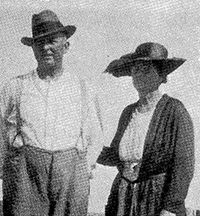
James and Maggie Stamp.
In 1888 James
Stamp and his brother John and family came to Keota from Illinois. They
bought one-half section of land two miles north and one mile east of
Keota. This land is still in possession of the Stamp families. James
took up as his work buying and shipping livestock. He bought stock for
miles around Keota and shipped from Keota and Nira.
260
A glimpse into the past...
He also fed
cattle and hogs for market so his farm was grassland.
In 1892 he
married Maggie Hauschilt of the Harper-Sigourney vicinity and they had
two daughters, Nita and Bessie.
In 1913 Mr. Stamp
rented his land and moved with his family to Iowa City in order that
the daughters might attend the University. The Stamps finished out
their lives in Iowa City.
In 1915 Nita was
married to Russell Bell of Iowa City who was at that time a salesman,
nine years with Remington Typewriter Company and at the time of their
marriage a piano and music salesman in Iowa City.
In 1917 the Bells
moved to the Stamp farm and continued the feeding of livestock and
farming in partnership with Mr. Stamp for a few years, then on their
own. After some years the Bells bought the 160-acre home of the
original Stamp land where they lived and brought up their three
children, namely, Beverly, James and Betty Jean.
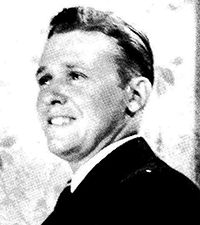
James Bell.
In due time the
girls married and left the farm but Jim stayed on and helped with the
work and also to add more land to the family ownership. Jim was his
grandfather's only grandson. In 1940 Jim met and married Thelmae
Fontenot of Lake Charles, Louisiana, and over the years they brought up
five children: Karen, Douglas, Pat, Robert and Curtis. Karen is now
Mrs. T. J. McDonald. Doug is living at Lake Tahoe, Nevada, after having
spent five years flying an attack bomber in the United States Navy. Pat
is married to Mary Ann Sieren and living on his own farm which joins
the old Stamp homestead. Robert and Curt are on the farm and very much
involved in the livestock feeding and farming, which goes on several
farms which Jim now owns in the same locality as the "old home."
Jim and his boys feed out several thousand head of cattle
and many hogs each year. The old homestead is still quite prominent in
this feeding process as it has been since 1888 when first purchased by
Mr. Stamp. As there are now a number of the fifth generation growing up
there, no doubt this old farm will remain in the family for many, many
more years. At this writing the fifth generation down the line from
James Stamp and wife numbers 12. So on this 100th Anniversary of our
great little town "Keota" there are many changes, all good, due to
onward progress, but there are also some things which remain the same
only with much improvement.
Nita
Stamp Bell

Stoutner Family
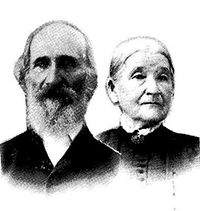
Dr. and Mrs. John S. Stoutner. |
Dr. John S. Stoutner was
born in Bedford County, Pennsylvania, April 5, 1823. He was the oldest
of a family of 10 children. He received his education at Willoughby
College in Ohio. He practiced medicine in Ohio and came west in 1854
locating at a place called Paris in Washington County, Iowa. He
practiced medicine there for nine years and then moved to Seventy-Six
Township, Washington County, on a farm three miles north of Keota. In
1890 he retired and moved to Keota. He died March 6, 1912.
He and his wife Mary Ann Keith, an Ohio girl, were
parents of six children, two of which were Oliver and William A. who
became prominent farmers in Washington County.
Oliver had three
sons—Charles and John Clyde who became farmers, and Frank who was a
Keota banker.
|
|
Charles had three sons—Bruce and Marion who are
farmers in the Keota area, and Keith who is a prominent businessman in
Chicago.
John Clyde had three sons and one daughter;
Albert, Boyd, Clyde Jr., also farmers. His daughter Helen is the wife
of Dudley Gretter, Chevrolet dealer in Keota.
The other son of Dr. John was William A., born
June 13, 1862. He married Martha McCaleb and they had four sons—George,
Edward, and Arthur, who all became farmers, and Walter a Keota banker.
After his wife's death he married Edna jones and they had three
sons—William jr., Burl, and Glen, who all became farmers in the Keota
area. His daughter Hazel is the wife of Robert Yoder, a contractor in
Keota.
George, born july 30, 1885, married Ethel Hagist.
They had two sons, Howard and Carl, who are farmers in the Keota area.
They are perhaps the oldest married couple in the Keota vicinity being
married 67 years and live in Keota. They have four generations now
living here.
Edward born August 27, 1887, had four children. He
lived most of his life in Illinois.
Arthur, born April 1, 1892, had two sons—Omar who
is a farmer and Everette who was a career officer in the Army.
Walter, born September 30, 1894, had two
daughters—Genevieve (Mrs. Leland Lyle) and Marjorie (Mrs. Aubrey See).
William Jr. was born January 8, 1908.
Burl, born July 5, 1918, had two sons—Dick and
Lynn, and one daughter Barbara.
Glen, born January 23, 1920, had one son, Kenny,
and three daughters: Glenda (Mrs. Gene Hammen), Charlotte (Mrs. Doug
Flander), and Shirley (Mrs. Mike Flynn).
|
261
A glimpse into the past...
Mrs. Hazel Yoder,
born February 23, 1912, had two sons—Myron, a carpenter, Keith, a
school teacher, and Joyce, wife of Jack Leedom.
Vincent
Family
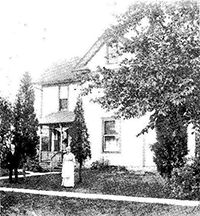
Vincent Family Homestead. |
Vincent, a French name, was carried to England
between the years of 1650 and 1660 by two brothers. They were joined by
a third family member later. A descendent, James Vincent, emigrated to
the American Colonies, settling in Cumberland County, Penn. His second
son, John, who was born in 1796, and his wife Jane Parr and six
children emigrated to Washington County, Iowa, in April, 1842.
Following his wife's death in 1843, he married Jane J. McCulley. After
renting 200 acres for two years, John filed his homestead claim. The
couple became the parents of six children. In later years, when John
Vincent was a prosperous farmer who could leave each of his children 80
acres, he would say that on his arrival in Iowa, he was forty-eight
dollars worse off than nothing and that he would have returned to the
east if he has possessed the means to get away. Mr. and Mrs. Vincent
and their son, John W., were killed when their wagon was struck by a
train as they were returning home from Keota. John Vincent's 12
children have a number of descendents in the Washington County area. |
|
George Gibson Vincent and Robert Gilmore Vincent,
sons of John Vincent, married Mary Theressa and Emma Wright, daughters
of Mr. and Mrs. John M. Wright, a pioneer Dutch Creek Township family.
Mr. and Mrs. Wright had come to Iowa to settle 80 acres granted to Mrs.
Wright as her father was a veteran of the War of 1812. During Mr.
Wright's service in the civil War, Mrs. Wright and the children
remained in the log cabin they had built on their claim. The Wrights
were parents of 10 children and celebrated their 60th wedding
anniversary in 1914.
George Gibson Vincent and Mary Theressa Wright
were life-long residents of the Keota Community and the parents of
seven children. George settled in 76 Township on 80 acres given to him
by his father and increased his holdings over the years. His oldest
daughter, Jennie Belle (deceased), married Isaac Pulver of 76 Township
and was the mother of three daughters. Charity Mae (deceased) married
Chalmers Sturgeon, a resident of Dutch Creek Township. Mr. and Mrs .
Sturgeon were the owners of the land where the Keota Community School
has lately been built. Nelle Anna (deceased) was a teacher who later
married Charles Weimer and they were the parents of one daughter. Earl
W. Vincent (deceased) served in the U.S. Congress and became a Judge of
the District Court. He and his wife, Madge Lee, were the parents of one
daughter. Martha Grace Vincent became a teacher and missionary of the
United Presbyterian Church, serving mission stations in Hawaii, Egypt
and Kentucky. She now resides at the United Presbyterian Home in
Washington.
Robert Elmer Vincent (deceased) married Clara B.
Horning of near Washington. Mr. and Mrs. Vincent settled on the
original Wright homestead and were the parents of two children. Their
daughter, Alice, married Wayne Mangold and they live near West Chester.
Two children were born to their marriage. The Vincents' son, Robert
Lester, married Esther M. Kephart of Sigourney and they are the parents
of four sons. Charles Robert, Gary Lee, Michael Gordon and William
George. These four descendents were the fifth generation to live on the
land granted to Isabella Clark Wright as a daughter of a veteran of the
War of 1812. Charles resides in Hamburg, Iowa, and has three children.
His wife was the former Mary Patricia McGuire, daughter of Dr. and Mrs.
K. L. McGuire of Keota. Gary and his wife, the former Rosemary Sheets,
daughter of Mr. and Mrs. Harold Sheets of Keota, live with their two
sons in Des Moines. Michael and William are still at home.
George Everett Vincent married Gladys Hunter after
service in World War I. Mr. and Mrs. Vincent settled on the George
Vincent home farm. Two children were born to the marriage. Gladys
Verlee Vincent married Martin Greiner of Keota. They reside in Colorado
Springs, Colorado, and are the parents of four children — three
daughters and one son. Dale E., the Everett Vincents' son, married
Phyllis George, daughter of Mr. Philip George and the late Mrs. Helen
George of Keota. They are the parents of three sons—Philip Everett,
Douglas Dale and Carl David. Philip is presently serving in the U.S.
Army and Douglas and Carl are at home. The Dale Vincent family lives on
the George Vincent home farm.
|
West
Family
Mr. and Mrs. W.
H. West with their sons Tom, Everett, Joe and daughter Martha (Mrs.
Loren Bennett) moved from Filmore County, Nebraska, to a farm one mile
west of Dublin in 1903. At one time they lived just west of West
Chester. The highlight of their farming was raising purebred Duroc
Jersey hogs. In 1910 they moved to Keota. Their home was a Stewart
house which was on of the oldest houses in Keota. Mr. West was employed
at the Lindle Hotel.
262
A glimpse into the past...
Bower
Family
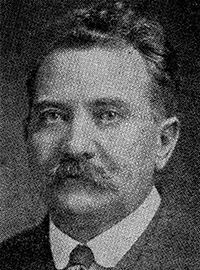 |
E. E. Bower was born October 7, 1864, near
Columbus, Ohio. Mr. Bower came to Iowa in 1888, worked for one year in
Harper then came to Keota where he clerked for H. Henkle after which he
became a partner in the firm of Henkle and Bower, general merchandise,
which later became Bower & Sanders, then later the Bower Company,
Inc. Mr. Bower was united to Clara A. Henkle June 6, 1892. They were
the parents of four children. Mr. Bower served as member of the school
board for 27 years, most of the time as President. Mr. Bower had added
burdens when the 1908 school was planned and erected.
He was active in the Baptist Church and served as
Superintendent of Sunday School for over 25 years.
Mr. Bower passed away September 24, 1914.
|
263
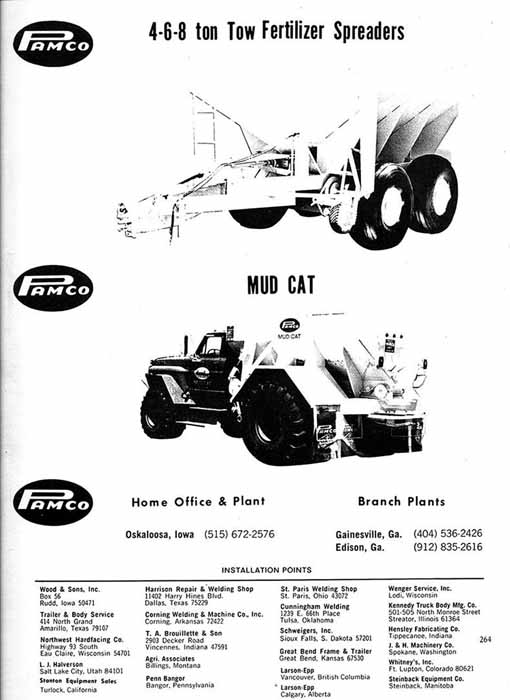
264
A
TRIBUTE TO OUR CENTENNIAL BOOK CHAIRMAN
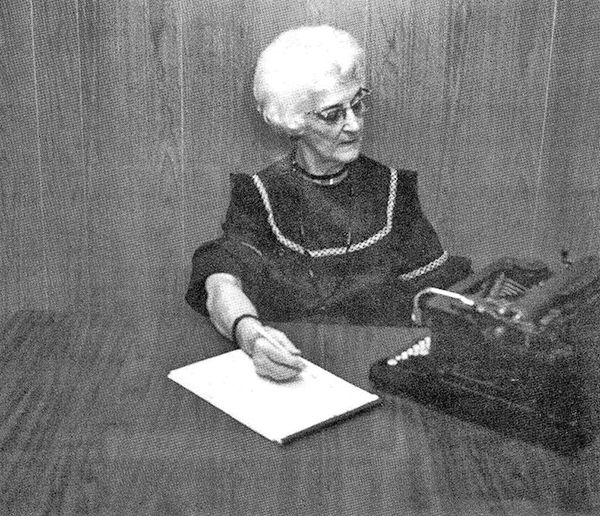
Our Centennial Book Committee Chairman, Cleo Bohrofen,
has made a special effort to compile the history of our town and
surrounding territory and to make it available to friends in a form in
which it can be kept readily available and referred to often.
The research and gathering
of pictures for the book has taken many many long hours and days of
hard work. For the past year Cleo has placed this book uppermost in her
life and we believe it to be the most complete history ever to be
compiled for the Keota area. Thanks, Cleo, for a job well done.
The Centennial
Committee
|
A special thanks to our very efficient advertising
chairman Lewis Powell and his committee — Roger Richardson, Maurice
Conrad, Mrs. Judy Wolf and Forrest Tucker — for doing a tremendous job
on the advertising found in this book.
The Centennial Committee
|
265
|